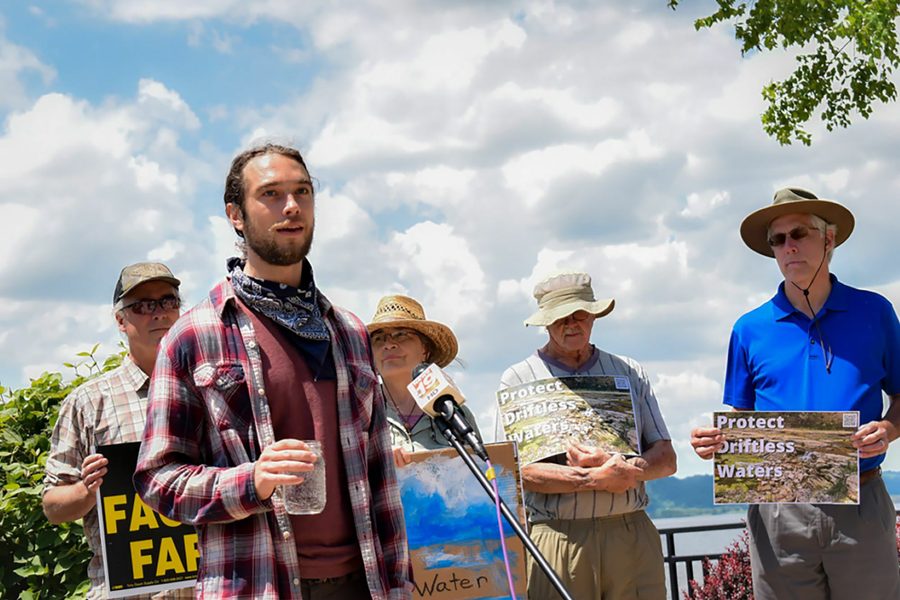A Wisconsin Hog Farm Would Produce 9.4 Million Gallons of Manure a Year. Nearby Residents Live in Fear.
Crawford County is up against Roth Feeder Pig II, which would be the largest hog CAFO in the state and could permanently pollute local aquifers.
Hannah Faris

CRAWFORD COUNTY, WIS. — When a neighbor tells Carl Schlecht and Kat Tigerman about an industrial hog farm planning construction on the narrow ridge above their home, they think it’s a joke. The retired couple lives along the Kickapoo River in the heart of southwest Wisconsin’s Driftless Area, one of the most rugged and ecologically sensitive regions in the state, and a massive industrial polluter moving in was too much to believe.
Now, Schlecht says, “It feels like an existential threat.”
For the past two and a half years, hundreds of residents, farmers and environmental advocates in rural Crawford County have fought to stop or regulate the proposed farm, Roth Feeder Pig II. It would house more than 8,000 hogs, doubling the size of its sister operation to become the largest concentrated animal feeding operation (CAFO) for hogs in Wisconsin, and generate 9.4 million gallons of manure annually to be spread on nearby fields.
The Crawford Stewardship Project (CSP), a collective of environmental scientists and advocates, warns the waste would endanger local waters. According to the CSP, the region’s sloping topography and fractured bedrock, along with an inadequate spreading area exacerbated by increasing rainfall, makes the area highly susceptible to water contamination.
“Our aquifers in the Driftless Area — once they’re polluted, they’re polluted forever,” says Kelvin Rodolfo, CSP volunteer and science professor at the University of Illinois Chicago.
When the CAFO was proposed, the CSP rallied neighbors and took their concerns to the township and county boards. In December 2019, the county enacted a one-year moratorium on CAFO construction and tasked a special committee with researching potential impacts. The resulting 222-page report found that CAFO manure runoff could render groundwater undrinkable.
The study points to Kewaunee County in northeast Wisconsin, a geologically similar region saturated with dairy CAFOs. There, 30% of private wells are unsafe to drink from because of high levels of nitrate and bacteria, such as E. coli and methicillin-resistant Staphylococcus aureus (MRSA). CSP, which runs a water monitoring program in Crawford, reports having already found MRSA in streams at Roth Feeder Pig I.
Air pollution is another concern. In North Carolina, a state dominated by industrial hog farming, the National Academy of Sciences found air emissions from swine CAFOs are linked to roughly 89 premature deaths annually in Duplin County. Overall, the report found farm pollution causes more than 17,000 U.S. deaths per year, outnumbering deaths from coal plants.
The Crawford County report also notes stench, infrastructure damage, zoonotic disease and plummeting property values as potential impacts. “[CAFOs are] deadly, pretty much all around, ” says Janet Widder, a farmer serving on the report committee.
Wisconsin state law, like its 2004 livestock facility-siting law, has paved the way for easy CAFO expansion, and some Crawford County residents fear the new CAFO is inevitable. “There are people who right now are trying to sell their house and [move] out,” says Forest Jahnke, CSP program coordinator.
According to attorney Adam Voskuil at Midwest Environmental Advocates, a nonprofit environmental law center, “[The siting law] removed a significant amount of local control.” Instead, there is a “one-size fits all” standard for CAFOs, and local governments are limited in enforcing anything stricter.
Per the law center, the siting law “has been used by the livestock industry to accelerate the growth of factory farming.”
Howard Roth, would-be owner of the proposed CAFO and a fifth-generation hog farmer in Crawford County, served as president of the Wisconsin Pork Producers Association, which has lobbied for deregulation, including the siting law. When reached for comment, Roth claimed he has taken the required precautions to prevent soil pollution and is not worried about air and water pollution. When asked about CSP finding antibiotic-resistant bacteria in his groundwater, Roth claimed his farm is not the source — because “only 1%” of his animals receive antibiotics.
Despite ongoing opposition, Crawford County’s one-year CAFO moratorium expired in December 2020. The county— among the poorest in the state— argued it couldn’t afford the research required by the siting law to try to prove the farm would pose health risks. Furthermore, the county fears Roth would litigate any potential regulation, another financial burden.
Just months prior in Polk County, Wis., industry groups sent a threatening letter to the county board hours before a vote on a CAFO moratorium extension there. The letter alleged an extension would violate the siting law, for which board members could face felony charges. While the Midwest Environmental Advocates has since argued that wouldn’t be the case, the board ended the moratorium.
The letter had a chilling effect on the Crawford County board, too, which tabled regulation discussions and suspended public comment. Now, community hope rests on intervention from the Wisconsin Department of Natural Resources (DNR). Throughout June, hundreds asked the DNR to issue an environmental impact statement, which could allow the agency to impose stricter regulations on the farm (such as requiring the installation of groundwater monitoring wells, making it possible to hold the farm liable for pollution).
Since 2014, Tyler Dix, permit coordinator at the DNR, only recalls two of Wisconsin’s 318 CAFOs having an environmental impact statement. Neither moved forward with construction.
Regardless of the outcome, some residents say, the fight is not over.
“When I’m not crying about it, it’s just staggering to me that this is what we have to fight,” Kat Tigerman says. “We’re not giving up the fight. Because we can’t.”
Hannah Faris is associate editor at The Wisconsin Idea, an independent reporting project of People’s Action Institute, Citizen Action of Wisconsin Education Fund and In These Times.








